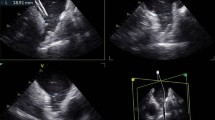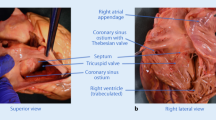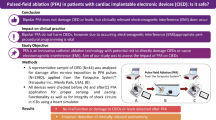Abstract
Purpose
To evaluate various strategies in order to minimize the risk of coronary injury during posteroseptal accessory pathways ablation in children.
Methods
We retrospectively reviewed 68 posteroseptal accessory pathways ablation procedures (20 decremental and 48 typical accessory pathways) performed in 62 pediatric patients at our institution between July 2009 and December 2016. Only posteroseptal accessory pathways targeted near or within the coronary sinus were included and ablation was mostly performed using irrigated tip radiofrequency.
Results
Median patient age was 11 years with a median body weight of 39 kg. Thirty patients underwent a coronary angiogram, 21 were coupled to the 3D navigation system CARTO-UNIVU™. The coronary angiogram showed a distance of less than 5 mm between the coronary artery and the ablation site in 40% of our cases; 3 patients had a coronary injury related to RF ablation, 6 patients were switched for cryoablation, 3 patients received limited RF energy (20 W). There were no demographic data predicting the proximity of the coronary artery to the ablation site.
Conclusion
Ablation of posteroseptal accessory pathways specifically in children carries a risk of coronary artery injury which is probably underestimated. The use of merged 3D images and coronary angiograms, the reduction of RF energy or the switch to cryoablation are possible alternatives to limit the risk of coronary injury.





Similar content being viewed by others
References
Kugler JD, Danford DA, Houston KA, Felix G. Pediatric radiofrequency catheter ablation registry success, fluoroscopy time, and complication rate for supraventricular tachycardia: comparison of early and recent eras. J Cardiovasc Electrophysiol avril. 2002;13(4):336–41.
Brugada J, Blom N, Sarquella-Brugada G, Blomstrom-Lundqvist C, Deanfield J, Janousek J, et al. Pharmacological and non-pharmacological therapy for arrhythmias in the pediatric population: EHRA and AEPC—Arrhythmia Working Group joint consensus statement. Europace. 2013;15(9):1337–82.
Macedo PG, Patel SM, Bisco SE, Asirvatham SJ. Septal accessory pathway: anatomy, causes for difficulty, and an approach to ablation. Indian Pacing Electrophysiol J 20 juill. 2010;10(7):292–309.
Asirvatham SJ. Difficulties with ablation for arrhythmias in children. Indian Pacing Electrophysiol J. 2008;8(Suppl 1):S55–74.
de Paola AA, Leite LR, Arfelli E. Mechanical reperfusion of acute right coronary artery occlusion after radiofrequency catheter ablation and long-term follow-up angiography. J Invasive Cardiol mars. 2003;15(3):173–5.
Schneider HE, Kriebel T, Gravenhorst VD, Paul T. Incidence of coronary artery injury immediately after catheter ablation for supraventricular tachycardias in infants and children. Heart Rhythm Off J Heart Rhythm Soc avr. 2009;6(4):461–7.
Tanel RE, Walsh EP, Triedman JK, Epstein MR, Bergau DM, Saul JP. Five-year experience with radiofrequency catheter ablation: implications for management of arrhythmias in pediatric and young adult patients. J Pediatr dec. 1997;131(6):878–87.
Stavrakis S, Jackman WM, Nakagawa H, Sun Y, Xu Q, Beckman KJ, et al. Risk of coronary artery injury with radiofrequency ablation and cryoablation of epicardial posteroseptal accessory pathways within the coronary venous system. Circ Arrhythm Electrophysiol févr. 2014;7(1):113–9.
Philip Saul J, Kanter RJ, Abrams D, Asirvatham S, Bar-Cohen Y, Blaufox AD, et al. PACES/HRS expert consensus statement on the use of catheter ablation in children and patients with congenital heart disease. Heart Rhythm juin. 2016;13(6):e251–89.
Mao J, Moriarty JM, Mandapati R, Boyle NG, Shivkumar K, Vaseghi M. Catheter ablation of accessory pathways near the coronary sinus: value of defining coronary arterial anatomy. Heart Rhythm Off J Heart Rhythm Soc mars. 2015;12(3):508–14.
Castaño A, Crawford T, Yamazaki M, Avula UM, Kalifa J. Coronary artery pathophysiology after radiofrequency catheter ablation: review and perspectives. Heart Rhythm. 2011;8(12):1975–80.
Bökenkamp R, Wibbelt G, Sturm M, Windhagen-Mahnert B, Bertram H, Hausdorf G, et al. Effects of intracardiac radiofrequency current application on coronary artery vessels in young pigs. J Cardiovasc Electrophysiol. 2000 May;11(5):565–71.
Al-Ammouri I, Perry JC. Proximity of coronary arteries to the atrioventricular valve annulus in young patients and implications for ablation procedures. Am J Cardiol. 2006;97(12):1752–5.
Rajbanshi BG, Rodrigues E, Lynch JJ, Gulati R, Sundt TM 3rd. Coronary artery spasm after Cryo Maze III procedure. Ann Thorac Surg. 2011;92(5):1884–7.
Aoyama H, Nakagawa H, Pitha JV, Khammar GS, Chandrasekaran K, Matsudaira K, et al. Comparison of cryothermia and radiofrequency current in safety and efficacy of catheter ablation within the canine coronary sinus close to the left circumflex coronary artery. J Cardiovasc Electrophysiol. 2005 Nov;16(11):1218–26.
Author information
Authors and Affiliations
Corresponding author
Rights and permissions
About this article
Cite this article
Alazard, M., Lacotte, J., Horvilleur, J. et al. Preventing the risk of coronary injury in posteroseptal accessory pathway ablation in children: different strategies and advantages of fluoroscopy integrated 3D-mapping system (CARTO-UNIVU™). J Interv Card Electrophysiol 52, 127–135 (2018). https://doi.org/10.1007/s10840-018-0339-x
Received:
Accepted:
Published:
Issue Date:
DOI: https://doi.org/10.1007/s10840-018-0339-x




